Bathroom decoration: design options, types of materials
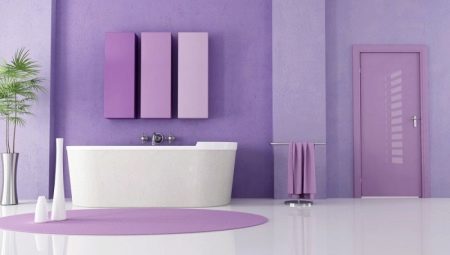
The bathroom is a place with a special microclimate. High humidity and temperature changes have a serious impact on the decoration of the room. That is why the choice of materials for bathroom decoration must be based on strict requirements. The finish must be durable, moisture resistant and hygienic. Only in this case, the interior will delight for many years with an impeccable appearance.
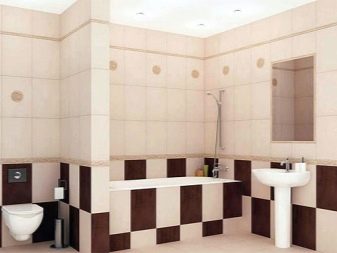

What is suitable for the walls?
There are several types of materials you can apply to make your walls look spectacular.
Dye
The easiest option is to paint the walls. Of course, the coating must be waterproof. Materials based on acrylic and latex are suitable. Among other things, they contain components that prevent the formation of mold and mildew. It only takes preliminary priming of the walls.

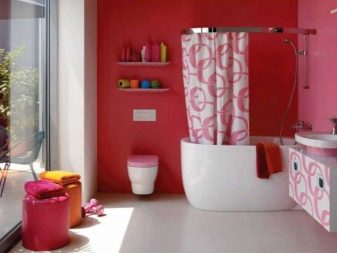
This solution will not require large financial costs. It will allow you to give the bathroom any shade, although such a finish will, of course, look rustic. In addition, it is worth noting that even the best quality coating can fade and start cracking over time.
Therefore, you need to be prepared for the fact that a repair update may be required.
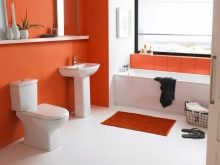

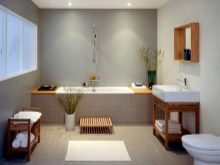
Ceramic tile
This finishing option is chosen most often. This is not surprising, because the stores offer a huge selection of models: both economy and premium class. The advantages of ceramics are numerous:
- high wear resistance (finishing serves for many years);
- environmental friendliness;
- resistance to moisture, detergents, temperature changes;
- hygiene (admissibility of wet cleaning);
- maintainability (the ability to replace one or more damaged elements).
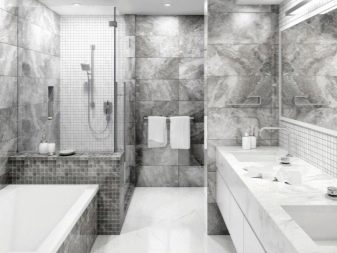
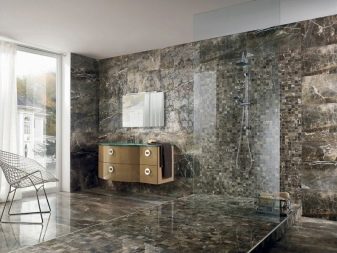
A distinction is made between ordinary and glazed ceramics. Colors, prints, sizes and shapes also vary. On sale there is a spectacular tile "hog", imitating brickwork. There are oversized models and small square varieties.
Recently, finishing with natural materials has come into vogue. Modern ceramic tiles successfully imitate stone, concrete, metal and even wood. Tiles can be used to bring to life a wide variety of design projects.
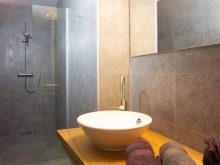

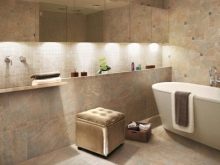
The lack of material can only be called complexity of installation. First you need to prepare the walls. They need to be leveled, primed, dried. The pipes are often covered with moisture resistant plasterboard.
The styling process requires certain skills and accuracy. Any distortions will be visible to the naked eye. In addition, the design of the corners is difficult. It will take making accurate calculations, trimming some elements.

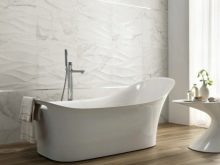
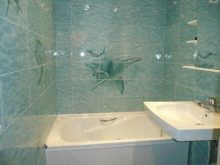
Mosaic
This is a rather spectacular coating, which is a collection of small particles of ceramics, stone, metal or glass. The elements are applied to a base (mesh), which is then mounted on the surface. Any color combinations, size and shape of particles can be used. Thanks to mosaics, you can easily achieve the effect of shimmering walls, smooth overflows of halftones or even a color gradient. Some canvases compiled by manufacturers allow you to create a drawing on the wall with a recognizable plot.
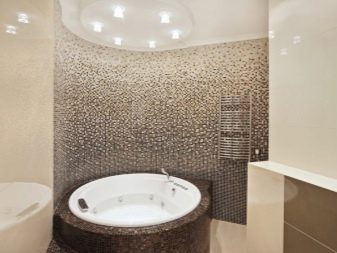

Like ceramic tiles, mosaic allows wet cleaning... It is resistant to bathroom conditions and retains its beauty for a long time. Due to the absence of visible joints, the material allows you to achieve a neat design in any difficult situations (corners, niches, rounded surfaces).
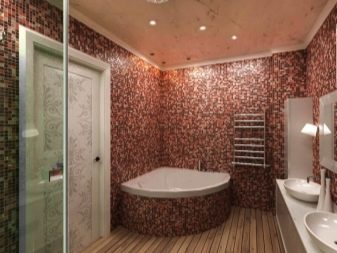
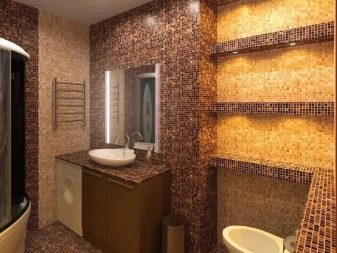
The disadvantages of the material include high cost, which is why not the whole room is often decorated with mosaics, but individual zones (for example, a shower corner). At the same time, when combined with large tiles, very effective interiors are obtained. Also, the disadvantages include difficult installation and fragility of some types of mosaics.
However, these issues can be easily solved: you just need to avoid hitting the walls, as well as the use of abrasives and aggressive chemicals.
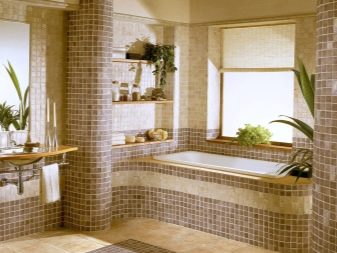
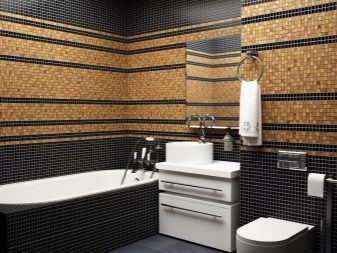
Plastic panels
Indoor siding is a plastic panel. Sometimes they are also called clapboard. The material is resistant to moisture and is inexpensive. Even a beginner in repair work can sheathe a room with them. Many people choose this particular option because of its practicality and availability.

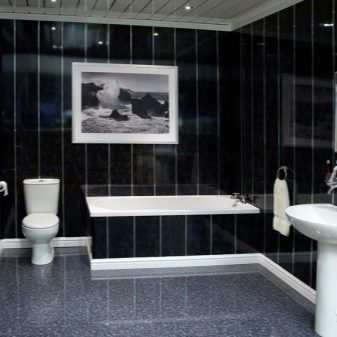
It should be noted that slatted panels are no longer used in modern interiors. Of course, they are still on sale, but this finish looks very cheap. A current alternative is panels that imitate bricks, ceramic tiles and even mosaics.
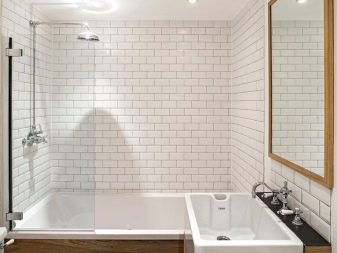
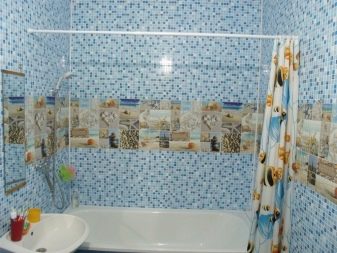
Some options look quite decent. However, there are also panels that can spoil the appearance of a room with their variegated and tasteless design. Therefore, in order to achieve the effect of a stylish space, you will have to try, choosing the color of the material. It is also worth remembering that due to the nature of the installation, such panels slightly reduce the usable space of the room.
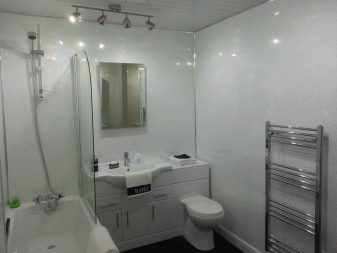
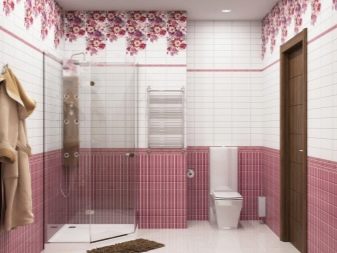
Decorative plaster
Moisture-resistant types of plaster give a beautiful, expensive effect. The walls can be shimmery with half-tones of the chosen noble scale or have a plain velvety covering. With the help of such material, luxurious classic interiors are often created, but sometimes it is also used in modern stylistic directions. Plaster combines perfectly with other materials and is widely used by professional designers.
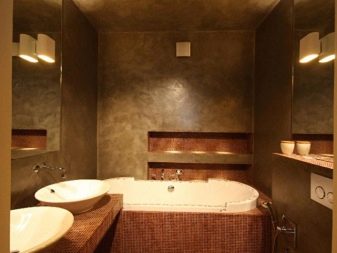
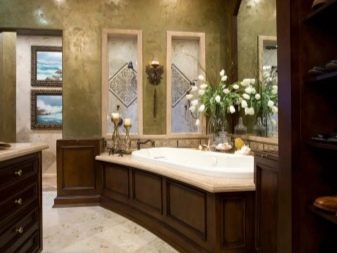
The coating does not fade or rub off over time. However, thorough wall alignment and a primer are required prior to application.The disadvantages of plaster include the risk of cracks if the house is in the shrinkage stage. Sometimes, to enhance the resistance of the material to the microclimate of the bathroom, it is covered with a protective varnish.
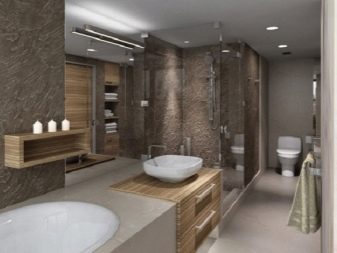
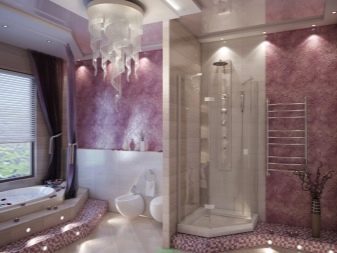
A natural stone
This is a rather expensive type of finish. Usually it is chosen for the design of spacious rooms with a solid interior. The stone is environmentally friendly, but it weighs a lot and does not like the effects of acids.
This makes it difficult to care for such surfaces.
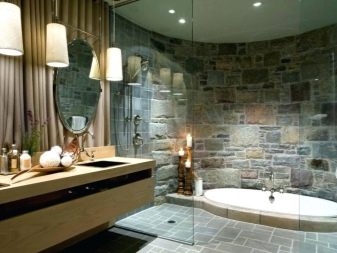

Fake diamond
If you want to decorate the bathroom with stone, but funds are limited, you can use an artificial analogue. Surprisingly, this material is considered a better choice for decoration compared to natural raw materials.
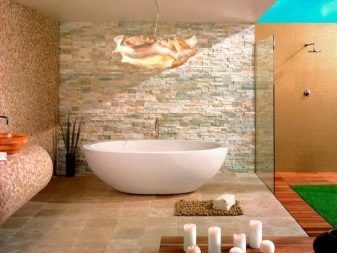

On sale you can find an imitation of any stone. A variety of shades and textures allows you to create a variety of interiors. The material is strong, resistant to mechanical stress, durable. The fungus does not develop on it, which allows us to talk about its hygiene. And most importantly - artificial stone weighs much less than natural. This makes it easier to install.
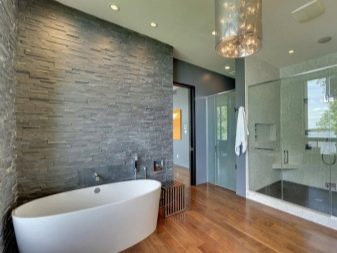
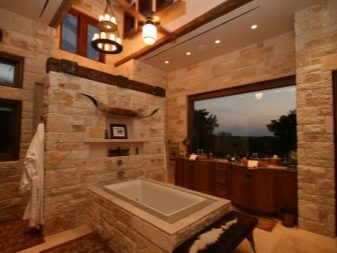
Types of materials for the ceiling
The following types of materials can be used to decorate the ceiling.
Lime
Whitewashing is the cheapest way to decorate a bathroom ceiling. To begin with, the surface is primed. If there is an old whitewash, it is washed off.
Lime is applied with a brush, roller or spray gun. During operation, it is imperative to cover the floor to avoid contamination. Otherwise, it will be difficult to clean the stains.

Dye
Coloring also refers to budget decor options.... As with whitewashing, the height of the room remains the same. No special skills are required for the job. It is only necessary to carry out preparation (removal of the old coating, primer).
It is important to choose moisture resistant paint. Manufacturers offer a wide range of such products. The composition is usually applied with a roller.
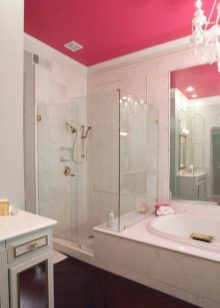
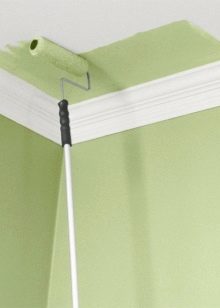

Traditionally, for the ceiling they choose White colorbut some are experimenting and with bright shades. Rooms look original in which the walls and floor have neutral tones (white, gray), and the ceiling is painted in a turquoise or pink shade. In this case, you can maintain a bright color with accessories. If the room is already full of rich colors and prints, it is better to make the ceiling snow-white. This will preserve the harmony in the design.
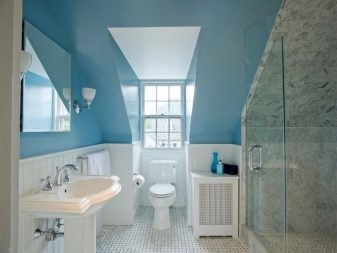
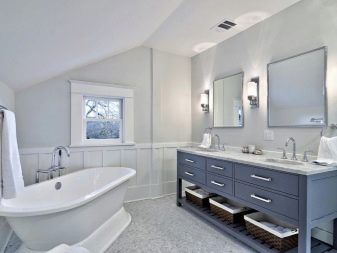
PVC stretch fabrics
Stretch ceiling is the most popular solution today. The canvas is stretched using a special technology and creates the illusion of a perfectly flat surface. The unique modern material is absolutely safe and has many advantages.
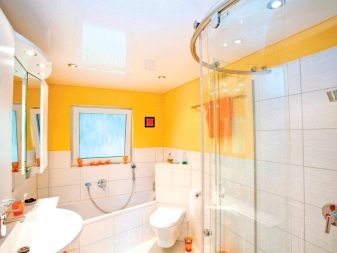

Stretch fabrics perfectly tolerate moisture, steam and high temperatures. At the same time, they remain dry, which eliminates the appearance of mold. When flooded by neighbors from above, such a ceiling can prevent damage to the repair, since it can retain a large amount of water.
This indicates the high strength of the material.

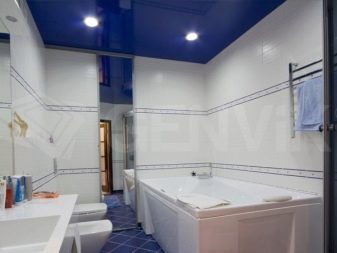
The stretch ceiling is washable. It is durable and looks great. Manufacturers offer many shades and textures. The canvas can be glossy or matte, smooth or embossed. Even the option with photo printing is possible. Also, such a solution opens up many possibilities for organizing lighting. These are spotlights and decorative pendant chandeliers.
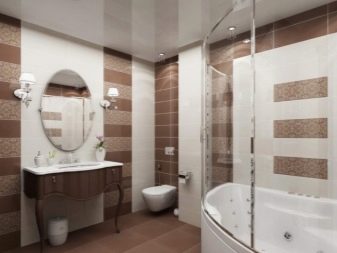

As for the disadvantages, here we can highlight impossibility of self-installation. Besides, the design reduces the height of the room by a few centimeters. However, these points are usually considered insignificant, especially given the many advantages of the material.
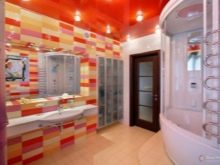
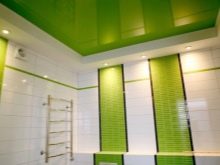

Plasterboard suspended structures
This option is usually chosen by the owners of spacious bathrooms with high ceilings. The basis of the structure here is a moisture-resistant green gypsum board, which is attached to a metal profile.The base coat can be of any shade. Choosing a suspended structure, you can make it multi-level, multi-colored, curly.
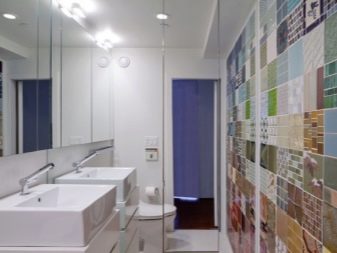
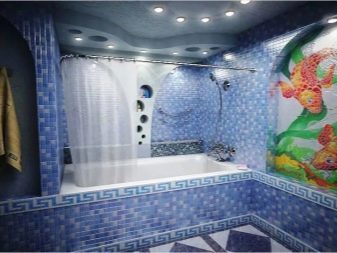
Suspended ceilings are reliable, durable and have a long service life. However, there are also disadvantages. The installation process of the structure requires professional skills. Like the previous version, this ceiling decoration method reduces the height of the room.
Usually, such surfaces cannot be washed. In addition, in small bathrooms, complex designs look cumbersome and inappropriate. If you choose between a conventional suspended and stretch ceiling, the second one wins in many respects.
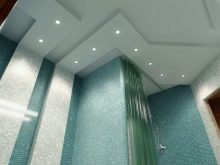
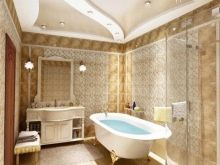
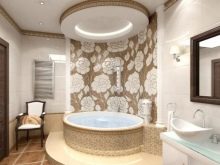
Plastic panels
Plastic is a budget option that can be used to decorate not only walls, but also the ceiling. There are several types of products offered by manufacturers. All of them are types of suspended structures and allow the installation of point spots.
- Seamless panels. The special design of the lock allows you to get a coating without noticeable joints.
- Rack and pinion models. They are open (with a gap between the parts) and closed (similar to lining).
- Cover with inserts.
Here, the gaps between the elements are covered with noticeable aluminum overlays.
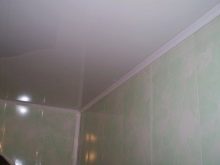
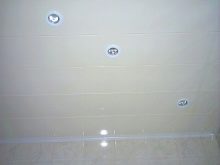
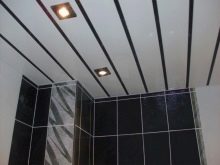
Mirror materials
A mirrored ceiling is a bold decision. Of course, it has a number of advantages. Such ceilings visually increase the height of the room and improve illumination due to the refraction of light fluxes. They are resistant to moisture, unpretentious in care, and look impressive.
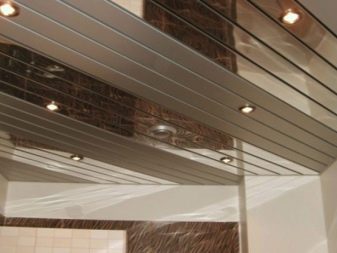

This solution can be implemented in different ways:
- chrome-plated aluminum slats;
- polystyrene elements with polyethylene film;
- mirrored square slabs.
The last option has the highest weight, therefore requires the most reliable fastening.
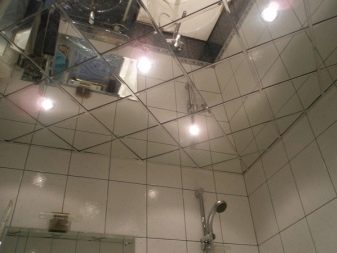
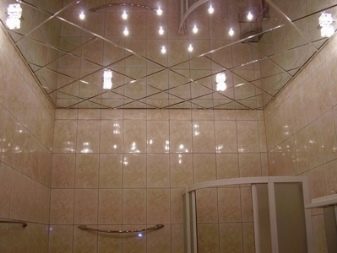
It is worth noting that a mirror surface can be a good solution in a spacious bathroom with luxurious finishes and perfect order. In a cramped room filled with furniture, household appliances, open shelves with many small items and other details, a reflective ceiling can create a feeling of complete chaos. Also worth mentioning are the glare that the ceiling can cast on the walls.
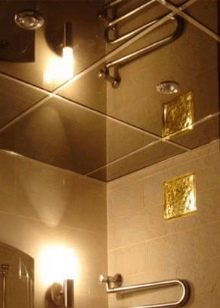


Wood
Wooden ceilings (for example, from larch) are most often found in private country houses. Environmentally friendly material gives comfort and a sense of unity with nature. The surface is sheathed with clapboard, keeping its natural shade and texture. However, you cannot do without a special impregnation that protects the material from moisture. Otherwise, the ceiling covering will quickly deteriorate and will require replacement.
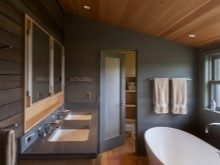
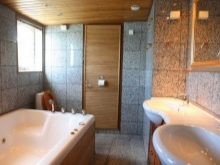
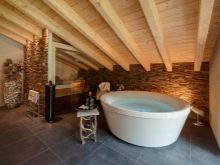
Floor design options
When decorating the floor, it is important to choose materials that will be very resistant to moisture, otherwise the coating will quickly swell and lose its appearance.
Linoleum
This is a budget floor finish that is great for the bathroom. The material is resistant to moisture and lasts a long time (from 15 years). It is easy and quick to fit, and the variety of modern options allows you to make a decent renovation. Some models successfully imitate parquet, and some - stone or ceramic tiles. If you lay the material with high quality and evenly, at first glance it will not even be possible to determine that it is linoleum.
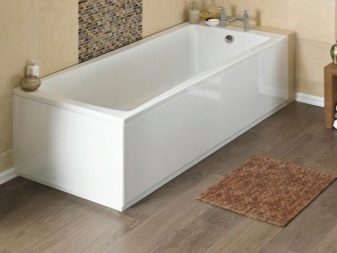
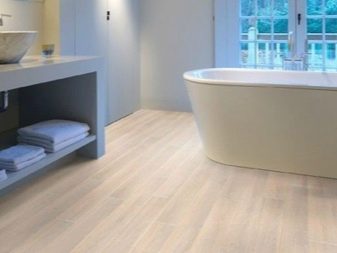
You can choose from a warm natural range or a neutral cool shade. If you wish, you can even find material in bright colors.
A bathroom with a blue or green patterned floor will look pretty cute.
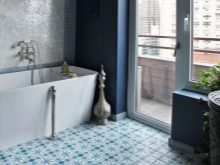


Ceramic or porcelain stoneware tiles
Here the choice of design is so wide that you can realize your wildest design fantasies. The tile can have any shape, size, color, texture. It can be plain or printed, imitate some natural material, or even make up whole pictures on the floor of a spacious bathroom. The only caveat is that it is better to choose non-smooth and non-slip tiles for the bathroom. This is due to basic security considerations.
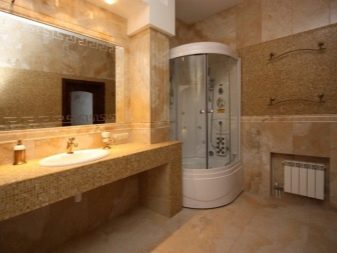
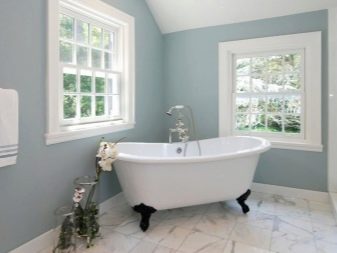
Otherwise, the choice is not limited. All models of ceramics and porcelain stoneware are resistant to moisture, durable and reliable. The price range also varies. On sale you can find both inexpensive options and luxury models for discerning buyers.
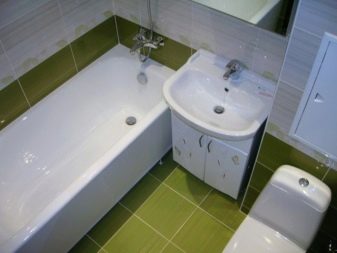

How to choose?
When choosing finishing materials for a bathroom, there are a few key points to consider.
Price
If repair costs are limited, it is better to give preference to inexpensive but durable materials. For example, you can put budget porcelain stoneware on the floor, and paint on the walls. The main thing is to properly level the surfaces and choose pleasant colors. You can only tile the walls in the water treatment area (by the bathroom or in the shower).

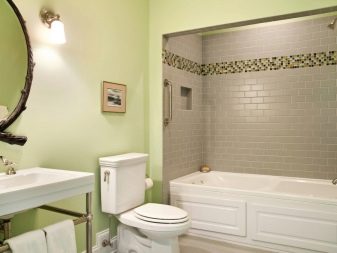
You can use plastic, but try to choose the current models. For example, imitation of white brickwork always looks advantageous. If you want to create the appearance of tiling walls, choose products that are not too colorful. If the collection has panels with large, very bright panels, let the drawing be one, and the rest of the walls remain background.

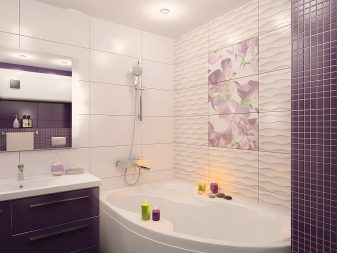
The same can be said for the average budget. Combining materials of different cost (for example, mosaics and ordinary tiles) allows you not only to save money, but also to add interesting details to the interior.
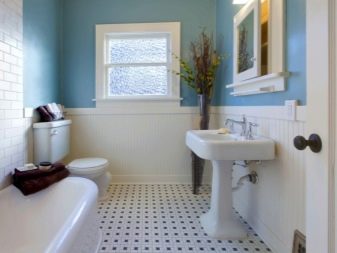

Style
If you adhere to a particular style in the design of the premises, this should also be reflected in the choice of materials. For example, luxurious classic interior can be created using decorative plaster, tiles "natural stone", suspended ceilings with vintage chandeliers.
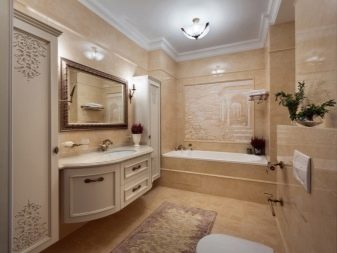
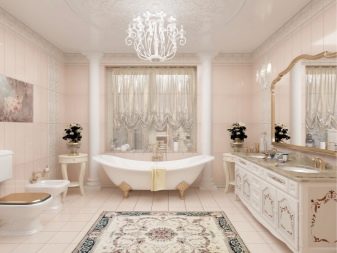
Scandinavian style assumes white walls (painting or tiles), imitation of wood. You can also put linoleum on the floor with characteristic black and white patterns. The ceiling can be whitewashed or painted.
Simplicity in this case is considered a plus.

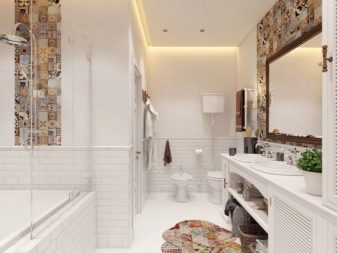
Minimalism assumes large-sized ceramics, monochromatic plastic. Pure, restrained colors, no prints are welcome here. Individuality is expressed through zoning. In this case, the best choice would be a stretch ceiling with built-in lights.
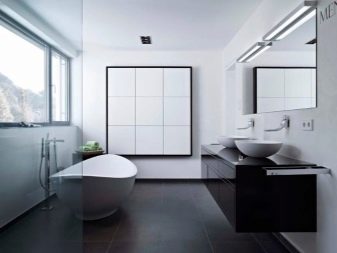
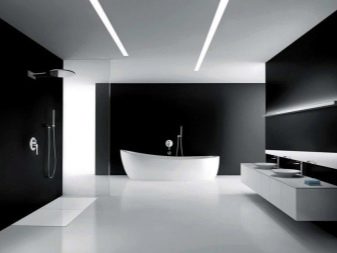
Modern makes it possible to show imagination. Any materials and combinations are appropriate here. The main thing is to observe the harmony of shades and adhere to some general design idea.
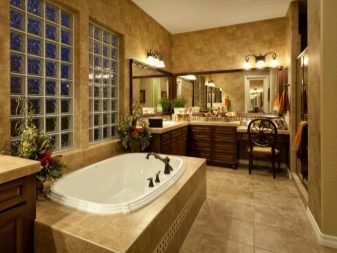
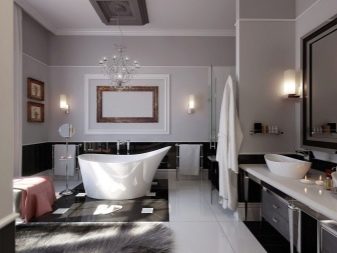
Colour
If you decide to buy colored plumbing or bathroom furniture, the finish should be neutral. It is also worth remembering the compatibility of materials. If tile or plastic with a pattern is chosen for the walls, let the floor be plain. Shades should also be in harmony with each other.
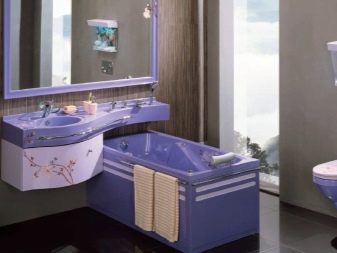
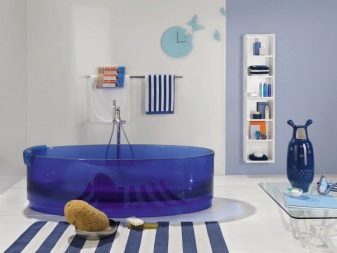
Remember that a riot of colors in a small space can only delight in the beginning. In the future, excessive variegation and brightness can begin to annoy. It will be especially offensive if you choose an expensive finish.
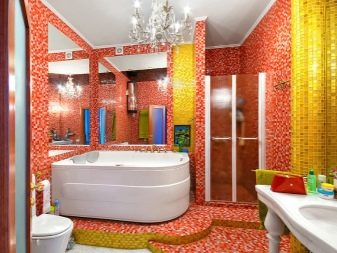
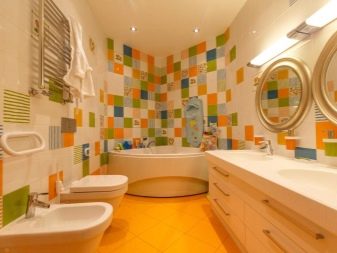
The best choice for bathroom decoration would be beige-brown or gray-blue range. Romantic natures can add to the setting light pink or peach tones. Modern look spectacular black and white interiors (with a predominance of whiteness). It is better to have more light shades in the room, especially if it is small. This will make the bathroom seem more spacious and comfortable.
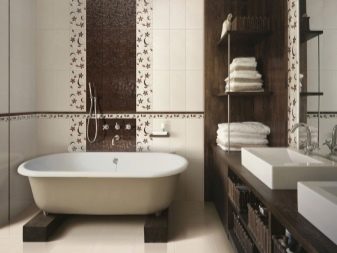
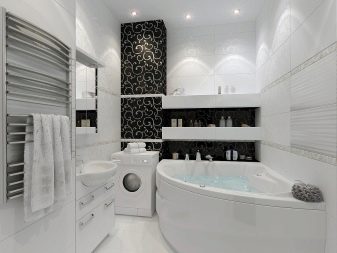
Beautiful examples in interior design
White and gold combination is the traditional choice for classic interiors. The atmosphere of royal luxury is created by imitation of gilding, marble and sophisticated vintage details.
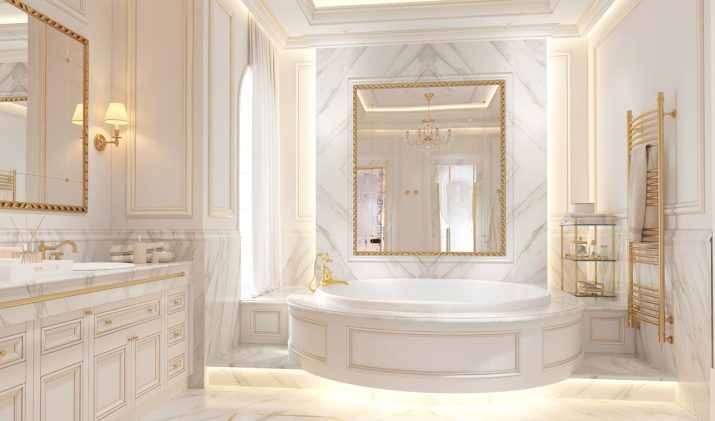
Strict black and white can also be sophisticated. Light tiles with small dark squares spice up any space.
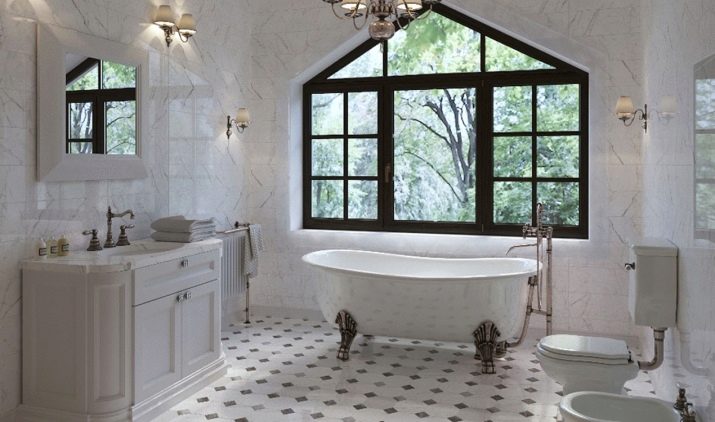
The sparkling shine of the mosaic fits perfectly into the concept of the Art Deco style. The restrained beige and brown palette allows the interior to remain elegant.
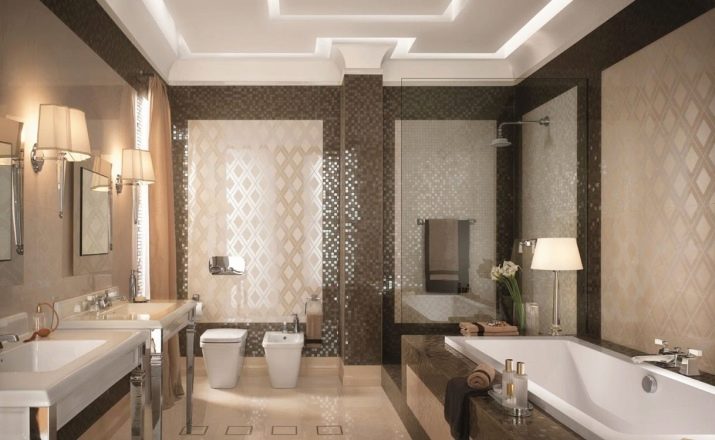
In a modern style, sand tones also look advantageous. Imitation wood makes the environment warm and cozy. A discreet delicate pattern on the walls fits perfectly into a small room.
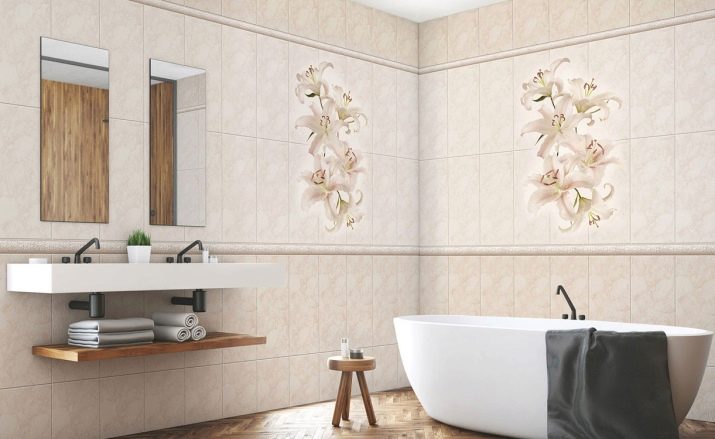
Custom-shaped tiles allow you to create original interiors, even in a laconic black and white design.
The perfect solution for connoisseurs of minimalism.
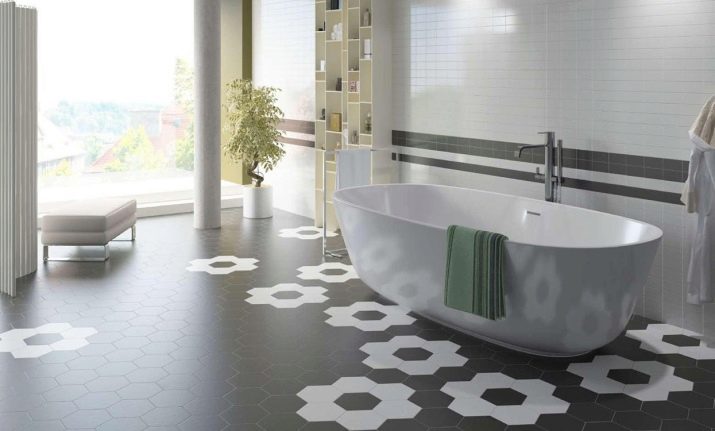
Turquoise in combination with white creates a feeling of sea freshnessvery appropriate in the bathroom. Not a bad choice for those who prefer bright colors.

See the following video for the secrets of decorating a bathroom with PVC panels.








